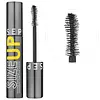What's inside
What's inside
 Key Ingredients
Key Ingredients

No key ingredients
 Benefits
Benefits

 Concerns
Concerns

 Ingredients Side-by-side
Ingredients Side-by-side

Water
Skin ConditioningStyrene/Acrylates/Ammonium Methacrylate Copolymer
Caprylic/Capric Triglyceride
MaskingEuphorbia Cerifera Wax
Synthetic Beeswax
Emulsion StabilisingPvp
Emulsion StabilisingCetearyl Alcohol
EmollientOzokerite
Emulsion StabilisingStearic Acid
CleansingCopernicia Cerifera Wax
Propylene Glycol
HumectantCI 77120
Cosmetic ColorantTriethanolamine
BufferingGlyceryl Stearate
EmollientPEG-100 Stearate
Triacontanyl Pvp
HumectantPanthenol
Skin ConditioningBenzyl Alcohol
PerfumingMethylchloroisothiazolinone
PreservativeCI 77266
Cosmetic ColorantIron Oxides
CI 77492
Cosmetic ColorantCI 77499
Cosmetic ColorantWater, Styrene/Acrylates/Ammonium Methacrylate Copolymer, Caprylic/Capric Triglyceride, Euphorbia Cerifera Wax, Synthetic Beeswax, Pvp, Cetearyl Alcohol, Ozokerite, Stearic Acid, Copernicia Cerifera Wax, Propylene Glycol, CI 77120, Triethanolamine, Glyceryl Stearate, PEG-100 Stearate, Triacontanyl Pvp, Panthenol, Benzyl Alcohol, Methylchloroisothiazolinone, CI 77266, Iron Oxides, CI 77492, CI 77499
Water
Skin ConditioningCI 77499
Cosmetic ColorantParaffin
PerfumingGlyceryl Stearate
EmollientSynthetic Beeswax
Emulsion StabilisingStearic Acid
CleansingAcacia Senegal Gum
MaskingButylene Glycol
HumectantPalmitic Acid
EmollientOryza Sativa Bran Wax
Skin ConditioningPolybutene
Styrene/Acrylates Copolymer
Vp/Eicosene Copolymer
Ozokerite
Emulsion StabilisingAminomethyl Propanol
BufferingHydrogenated Vegetable Oil
EmollientPhenoxyethanol
PreservativeStearyl Stearate
EmollientHydroxyethylcellulose
Emulsion StabilisingCellulose
AbsorbentSodium Nitrate
SoothingSodium Dehydroacetate
PreservativeSilica
AbrasiveGlyoxal
AntimicrobialWater, CI 77499, Paraffin, Glyceryl Stearate, Synthetic Beeswax, Stearic Acid, Acacia Senegal Gum, Butylene Glycol, Palmitic Acid, Oryza Sativa Bran Wax, Polybutene, Styrene/Acrylates Copolymer, Vp/Eicosene Copolymer, Ozokerite, Aminomethyl Propanol, Hydrogenated Vegetable Oil, Phenoxyethanol, Stearyl Stearate, Hydroxyethylcellulose, Cellulose, Sodium Nitrate, Sodium Dehydroacetate, Silica, Glyoxal
Ingredients Explained
These ingredients are found in both products.
Ingredients higher up in an ingredient list are typically present in a larger amount.
Ci 77499 is also hydrated iron III oxide. It is created from mixing red and black iron oxides. This helps give shades of darkness to a product.
Iron III oxides are classified as inorganic chemicals for coloring.
Glyceryl Stearate is a mix of glycerin and stearic acid.
It is used to stabilize the mixing of water and oil ingredients. By preventing these ingredients from separating, it can help elongate shelf life. It can also help thicken the product's texture.
As an emollient, it helps soften skin and supports barrier-replenishing ingredients.
In cosmetics, Glyceryl Stearate is often made from vegetable oils or synthetically produced.
This ingredient may not be fungal-acne safe
Fun fact: The human body also creates Glyceryl Stearate naturally.
Learn more about Glyceryl StearateOzokerite is a naturally occuring mineral wax. In cosmetics, ozokerite is used as a texture enhancer.
Ceresin wax is derived from this ingredient.
The melting point of ozokerite is 58-100 C.
Ozokerite is found all over the world including Scotland, the US, and India.
Learn more about OzokeriteStearic Acid is a fatty acid. It is an emollient, emulsifier, and texture enhancer.
As an emollient, stearic acid helps soften skin. It aids the skin's protective barrier by preventing water loss. It also provides a gentle cleansing effect without stripping away natural oils.
Stearic acid may also be used to enhance the texture of products. It can add volume and stabilize ingredients such as water and oil. This can help water and oil ingredients from separating.
Sources of stearic acid include animal or vegetable fats/oils such as coconut or shea. It can be naturally found in butter, cocoa butter, shea butter, vegetable fats, and animal tallow.
This ingredient may not be Malassezia folliculitis, or fungal-acne safe.
Learn more about Stearic AcidSynthetic beeswax is created to be identical in structure to beeswax. It possesses the same occlusive and emulsion properties.
A blend of fatty acid esters, fatty acids, and alcohols are used to create synthetic beeswax. Whether or not this ingredient is vegan depends on the source. Sometimes, lanolin is used for its creation.
This ingredient may not be Malassezia folliculitis, or fungal-acne safe.
Learn more about Synthetic BeeswaxWater. It's the most common cosmetic ingredient of all. You'll usually see it at the top of ingredient lists, meaning that it makes up the largest part of the product.
So why is it so popular? Water most often acts as a solvent - this means that it helps dissolve other ingredients into the formulation.
You'll also recognize water as that liquid we all need to stay alive. If you see this, drink a glass of water. Stay hydrated!
Learn more about Water